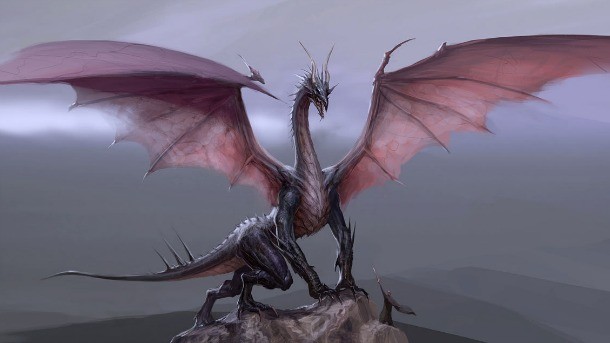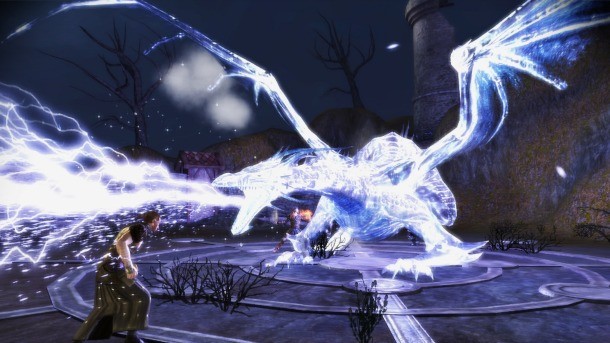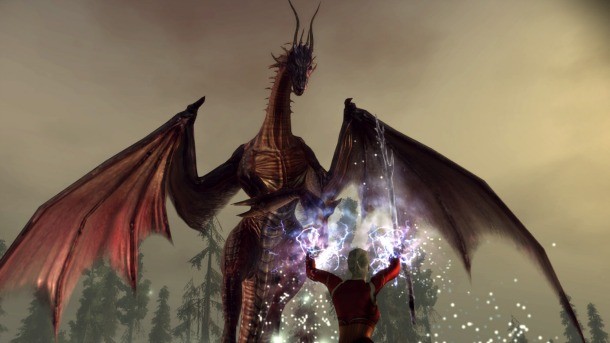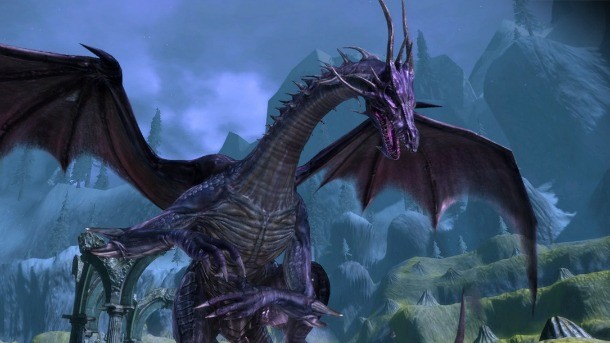Please support Game Informer. Print magazine subscriptions are less than $2 per issue
Putting The Dragons In Dragon Age

Few fantasy creatures are as recognizable as dragons, a fact that can be a blessing and a curse for a video game. They have the potential in inject jaw-dropping moments, but creating a vision for the creatures that is not clichéd can be challenging. This is especially important for a series that sets expectations with a name like “Dragon Age,” but BioWare has found success making its dragons interesting – and the team is making even bigger strides with Dragon Age: Inquisition.
Dragon Age draws its name from the period of time in the world that the franchise chronicles. An age spans 100 years, and each is named for significant events occurring at the time. In this case, after being hunted nearly to extinction, dragons began reappearing in the world thanks to old clutches of eggs finally hatching.
“There was this massive battle between the Fereldens and the Orlesians,” says Inquisition’s creative director Mike Laidlaw. “The Fereldens were winning, and a dragon did a fly-by, and they were like, ‘Wow. That’s a sign. We know what this next age is going to be called.’”

Seeing a dragon fly over the battlefield isn’t just an intimidating sight in the world of Dragon Age; it means something. “The Dragon has always been this agent of change and tumult,” Laidlaw says. “It’s almost like an astrological sign – except rad.“ This symbolic importance of dragons plays a major role in Inquisition. It may not be set during the turning of an age, but more dragons exist in the world than any during any previous Dragon Age title, which can only mean a shake-up of the current order.
“They’re emblematic – not symptomatic – of the change that’s sweeping across the nations,” Laidlaw says. “As the dragons come back and become more prominent…the world is getting increasingly unstable. Through its own forces, through blights – you name it.”
Apart from what they represent, an influx of dragons presents another problem. Unlike the classic Dungeons & Dragons versions of the beasts – intelligent, magically gifted – the dragons of Thedas don’t have nuanced personalities or complex motivations. They are hunters, first and foremost. “Our dragons are basically apex predators,” Laidlaw says. “They are about as intelligent a very smart dog. We’ve compared them to the mabari [hounds].”
So, not only is the world full of strife, but it is also crawling with vicious predators. It’s a dangerous time for a resident of Thedas, but an opportune time for heroes anxious to prove their bravery.
Next: How to fight dragons

When designing battles against dragons in Inquisition, the team at BioWare is careful to ensure that players get the right mixture of challenge and achievement. If you fight dragons during every quest, they lose all of their impact. If they are so challenging that they are only appropriate for end-game characters, then players can’t engage with one of the coolest parts of the Dragon Age world. Inquisition finds a balance between those two extremes.
Unlike Dragon Age II, very little of the content in Inquisition is scaled to the player’s level. That means that some parts of the world will have enemies that are too difficult to defeat until you reach a certain level. This approach conveys a satisfying sense of progress; few things in an RPG are more rewarding than finally defeating a foe that was previously beyond your abilities. That’s the driving idea behind how dragons are implemented in Inquisition. “I don’t ever want a player to casually kill a dragon,” Laidlaw says. “I see a dragon as something you aspire to. You see it flying overhead and make future plans. ‘I’ve seen that there’s a dragon. I know what kind of environment I’m going to be up against. I know what I’m going to fight on my way in. So I’m going to need to prepare accordingly.’”
However, even though dragons present a great challenge, they have different incarnations that allow players to get a taste of draconic content without hitting level cap. Defeating a regular dragon, while difficult, is an attainable goal for a reasonably powerful character. However, high dragons have the best loot and rarest crafting materials, and those might have to wait until much later in your journey. In any case, fights against dragons are being treated as optional battles that you prepare for deliberately and undertake carefully.

Because confrontations with dragons are placed encounters (not random, as opposed to games like Skyrim), BioWare is able to design them for specific environments and situations. “We need to consider them as something we should be tuning,” Laidlaw says. “Their environment should have some nice lead-in. You should feel that anticipation. You should clench up a little. And when they appear, they should be aware of the space in which you’re fighting them and be able to use that.” For example, if you fight a dragon in a rocky clearing, you may be able to take cover from its breath weapon behind boulders. However, the dragon can flush you out by concentrating its fire to melt the stone.
No one tactic works for every fight, and they are intended to be difficult. In fact, you have the option to withdraw from some of these encounters in case you bite off more than you can chew. So, how can your Inquisitor defeat these colossal foes? Each one is a little different, but you can find and create gear that gives you an edge against dragons. You should also pay attention to the dragon’s behavior and environment, because your tactics may change as the fight goes on. “You can individually target their limbs, and they react to the damage to a leg versus another one,” says Laidlaw. “I think that helps ground the encounter a lot more. If you need to get in close to the legs, we open up a whole new realm of counter-moves. He can take a swipe at where you likely are, which feels more like what a real beast would do. It grounds the encounter, and keeps it very physical.”
As much as we want to know more about how these fights play out, the team at BioWare is keeping quiet about the specifics. However, fans of the series should know that they will fight more dragons than in previous installments, and that they will have more options than ever before. “The global approach to Inquisition is that we want to give the player more freedom,” says Laidlaw. “When I think about what we’re doing with dragons, we’re making them a goal. We’re making them something that you can do. There are elements of dragons that are integral to the story, and that I absolutely won’t tell you about. There are elements of dragons that are aspirational fights that you’re drawn to. We’ve done that before, but I see us building tools that the player has that allow him or her to get better at dragon slaying.”
For more exclusive Dragon Age: Inquisition coverage, click the banner below to visit the game's hub.











